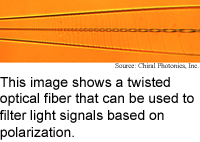
Twisted fiber filters light
Researchers from the City University of
New York, Queens and Chiral Photonics, Inc. have devised a way to control
light inside optical fiber communications lines.
The method involves putting periodic twists in fiber to select
the polarization of light that is transmitted through the fiber. The electric
field of an unpolarized light pulse or beam is oriented on a plane perpendicular
to the pulse or beam. When light is polarized its electric field is narrowed
to one direction within the plane or rotates around the plane.
Telecommunications networks, navigation system gyroscopes, and
optical current sensors that monitor electric power stations all depend
on polarized light.
The method could enable faster data transmission rates in fiber-optic
lines and new twists on devices like lasers and sensors.
The researchers made their prototype chiral fibers using a relatively
simple process: heating the optical fiber, then quickly and precisely
twisting the fibers so that the fiber core forms a double helical structure
much like DNA. The effect of the structure on light depends on how tightly
the fiber is twisted.
A loose twist allows the device to act as a sensor, a moderate
twist acts as a polarizer, and a tight twist acts as a filter or laser.
The researchers' prototype devices include pressure, temperature and fuel
sensors.
The researchers have produced a practical in-fiber light polarizer,
and plan to produce a chiral fiber laser within 18 months, according to
the researchers. The work appeared in the July 2, 2004 issue of Science.
Projector lights radio tags
Cell phone melds video and data
Sound system lets listeners move
Chips measure electron spin
Briefs:
Twisted fiber filters light
Shifty tiles bring walking to VR
Speck trios make secret codes
Single gold atoms altered
Pen writes micro wires
Design eases nano locomotion

Research Watch blog
View from the High Ground Q&A
How It Works
RSS Feeds:
News
Ad links:
Buy an ad link
Ad links: Clear History
Buy an ad link
|
TRN
Newswire and Headline Feeds for Web sites
|
© Copyright Technology Research News, LLC 2000-2010. All rights reserved.